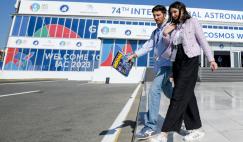Thanks to the highly successful Cassini-Huygens mission, any future investigations will be well acquainted with conditions on Titan before they set out towards this enigmatic world in orbit around Saturn. What can past missions tell us about the environment on this mysterious moon?
Titan is Saturn’s largest satellite and one of the most intriguing moons in our solar system, in particular from an astrobiological perspective because of its large organic content in the atmosphere and on the surface and because of the probable subsurface ocean of liquid water.
Titan, which is larger than the planet Mercury, has a dense and extended atmosphere consisting essentially of nitrogen with some methane and hydrogen, along with trace gases such as hydrocarbons and nitriles produced through photochemistry and photolysis in the upper atmosphere.
This very advanced organic chemistry diffuses downward in the form of aerosols and condensates and is finally deposited on the surface, where it pools as rivers, lakes and seas. Scientists have obtained data on Titan from ground-based telescopes, Earth-orbiting observatories and deep space missions, such as those returned by the Cassini-Huygens spacecraft for well over a decade now. Their analysis reveals a complex system where organic content is distributed from the upper atmosphere to the surface and an interior that may vary with seasons, much like on Earth albeit on much longer timescales. Studying this far-away world not only gives us clues as to the formation and evolution of our own planet but of habitable conditions in the solar system and beyond.














